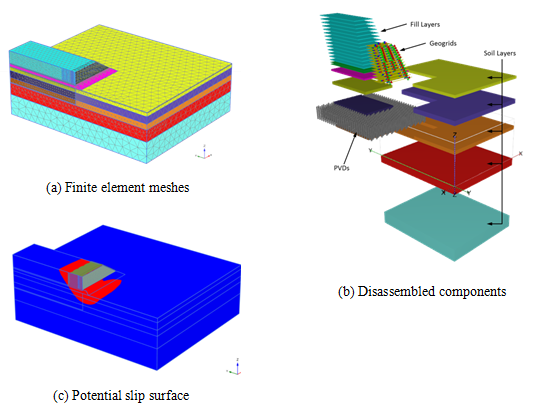Geosynthetic reinforced soil (GRS) structures (walls, slopes, embankments, foundations, pavements, etc.) have been widely used throughout the world. GRS structures have many advantages including aesthetics, short construction period, good wall stability, cost effectiveness, good seismic response, strong adaptability on compressible foundation soils and the ability to tolerate differential settlement. The behaviour of GRS structures constructed on a competent (very stiff or rigid) foundation material has been extensively researched through both experimentally and theoretically in the past, and many current design codes are partially based on this research. However, the same cannot be said for foundation soils that experience plastic yielding due to the loading induced by GRS structures construction, and there has been very little previous research into the effect of foundation deformation on the overall performance of the structures. Design of such structures without considering foundation deformation would lead to less safety or even failure.
Objective
1) To reveal the behavior and performance of GRS structures on yielding foundation; 2) to investigate the measures to improve the stability of GRS structures on yielding foundation; 3) to compute the factor of safety of GRS structures considering hardening of soft clay; and 4) to propose a novel design method for GRS structures on yielding foundation.
Approach
Field testing, centrifuge and numerical modelling were performed.
Significant Results and Potential Impact
1) The deformation of foundation leads to an apparent increase of the loads in the bottom reinforcements, which should be considered in design; 2) the stability of GRS structures can be apparently improved by extending the bottom reinforcements. Besides, strength and stiffness of the reinforcements also influence the factor of safety of the structures. Ignoring reinforcement strength may lead to overestimation of the stability of the structures; 3) the stability of GRS structures can be captured by the limit equilibrium method with the increased shear strength values assigned to the consolidated zone directly beneath the reinforced structure and with the unconsolidated-undrained shear strength values assigned to the unconsolidated zone beyond the structure; and 4) physical and numerical modelling was performed on new-type GRS structures with rigid/flexible facing which can adapt large settlement or differential settlement of foundation. A novel design method considering the foundation deformation and the stiffness of rigid/flexible facing was proposed.
Principal Investigator:
Jianfeng Chen, Zhenming Shi, Songbo Yu
Funding
National Natural Science Foundation of China (50508030), National Natural Science Foundation of China (41072200), Shanghai Pujiang Program (14PJD032).
Key Publication
(1) Chen, J.F., Yu, S.B. Centrifugal and numerical modeling of a reinforced lime-stabilized soil embankment on soft clay with wick drains. ASCE, International Journal of Geomechanics, 2011, 11(3): 167-173.
(2) Chen, J.F., Yu, S.B., Xue, J.F., Shi, Z.M. Experimental measurement and numerical computation of geogrid tension in centrifuge modeling. KSCE, Journal of Civil Engineering, 2011, 15(8): 1343-1348.
(3) Zhou, J., Chen, J.F.(Corresponding author), Xue, J.F., Wang J.Q. Micro-mechanism of the interaction between sand and geogrid transverse ribs. Geosynthetics International, 2012, 19(6): 426-437.
(4) Xue, J.F., Chen, J.F.(Corresponding author), Liu, J.X., Shi, Z.M. Instability of a geogrid reinforced soil wall on thick soft Shanghai clay with prefabricated vertical drains: a case study. Geotextiles and Geomembranes, 2014, 42(4): 302-311.
(5) Chen, J.F., Liu, J.X., Xue, J.F., Shi, Z.M. Stability analyses of a reinforced soil wall on soft soils using strength reduction method. Engineering Geology, 2014, 177: 83-92.
(6) Chen, J.F., Liu, J.X., Xue, J.F., Shi, Z.M. Failure analyses of a reinforced embankment by strength reduction and limit equilibrium methods considering hardening of soft clay. KSCE, Journal of Civil Engineering, 2014, DOI: 10.1007/s12205-014-0288-6
(7) Chen, J.F., Liu, J.X., Xue, J.F. Centrifugal test on a reinforced soil wall with flexible/rigid facings under working stress. Journal of Tongji University (Natural Science), 2014.
(8) Chen J.F. and Bathurst R. Investigation of interface toe sliding of reinforced soil block face walls using FLAC. Continuum and Distinct Element Numerical Modeling in Geomechanics, Zhu, Detournay, Hart & Nelson (eds.), Itasca International Inc., Minneapolis, ISBN 978-0-9767577-3-3, 2013: 04-05.
Fig.1 Field testing of a GRS structure on yielding foundation

Fig.2 3D refine modeling of a GRS structure on yielding foundation

Fig.3 Centrifuge modelling of new-type GRS structures with rigid/flexible face



